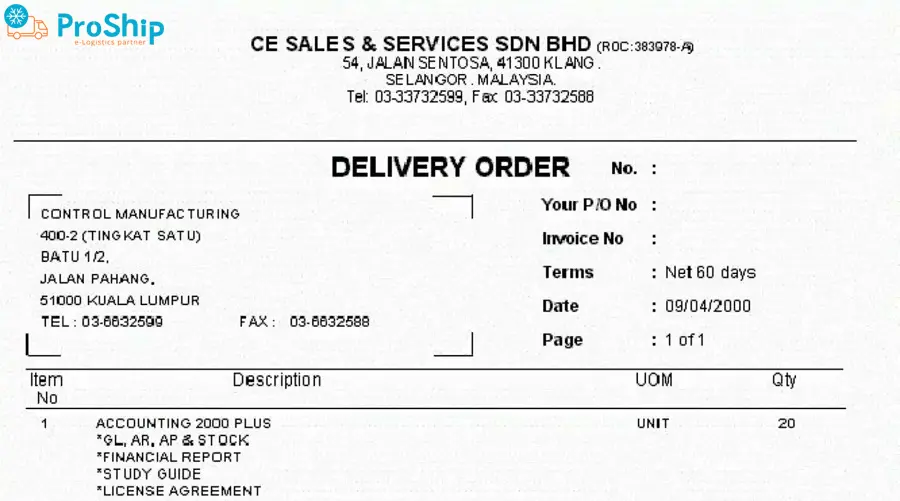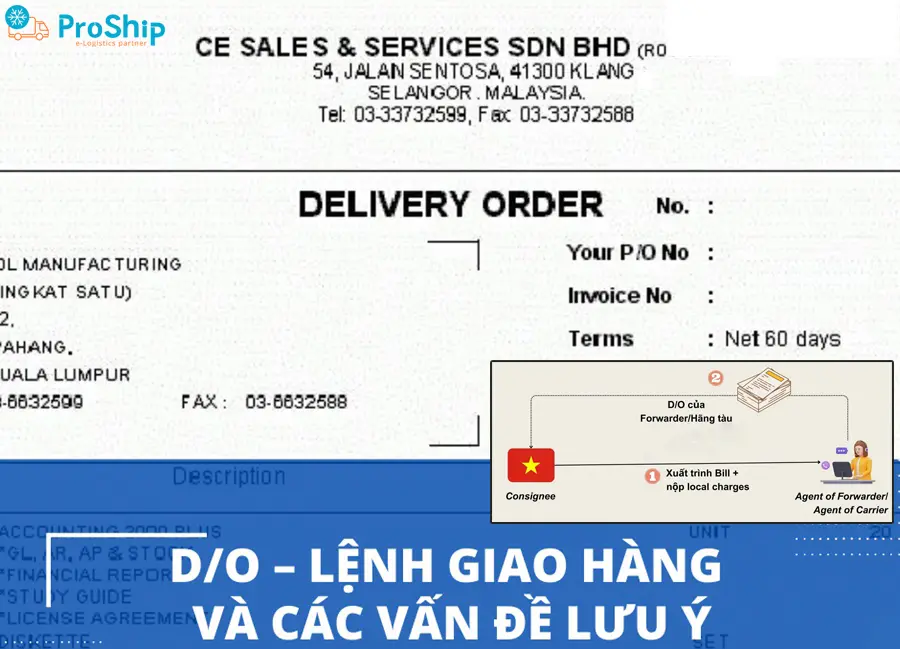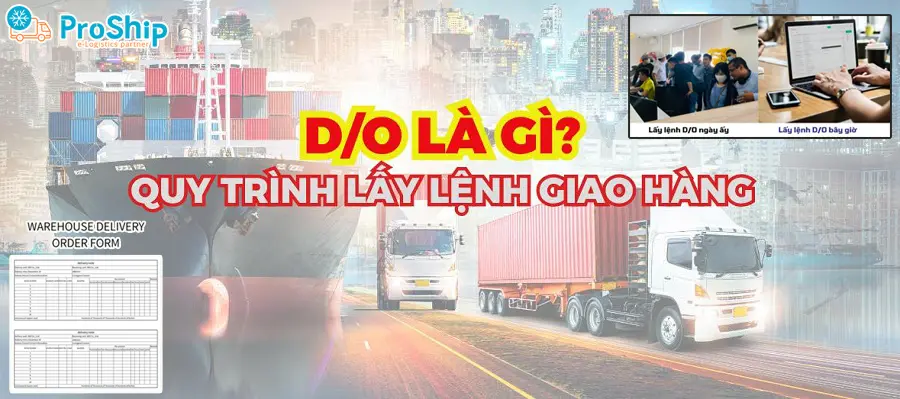x Các doanh nghiệp, chủ hàng cần tìm hiểu về các loại phí thông dụng trong xuất khẩu, nhập khẩu (trong đó có phí DO)?
x Bạn muốn biết quy định, nội dung, cước phí, cách tính D/O trong vận tải hàng đường biển thế nào?
x Bạn cần nắm quy trình thực hiện lấy lệnh giao hàng D/O trong xuất nhập khẩu quốc tế?
Trong ngành vận tải quốc tế, lệnh giao hàng D/O là thuật ngữ khá phổ biến. PROSHIP.VN chúng tôi sẽ giải đáp nhanh mọi thắc mắc liên quan tới D/O, bao gồm DO trong xuất nhập khẩu là gì; DO trong xuất nhập khẩu quy định thế nào, cách tính ra sao; quy trình lấy lệnh giao hàng DO thế nào,…ngay sau đây.
>>XEM THÊM: Nhận vận chuyển Container giá rẻ
Phí D/O là gì? Nội dung gồm những gì?
Phí D/O là gì?
DO trong xuất nhập khẩu là gì? D/O – Delivery Order trong tiếng Việt là lệnh giao hàng, là chứng từ quan trọng trong hoạt động giao nhận hàng quốc tế. D/O được hiểu như là lệnh của người giữ hàng chỉ thị cho người nhận hàng để lấy được hàng. D/O được hãng tàu/ FWD phát hành để khách hàng xuất trình với hải quan và được phép lấy hàng từ kho bãi về.
Phí D/O – Delivery Order fee là phí lệnh giao hàng. Được hiểu đơn giản là phí mà hãng tàu hoặc FWD làm lệnh DO cho khách khi có hàng nhập khẩu nhận được để trình cơ quan hải quan cửa khẩu để được rút hàng từ kho bãi về.
Để tránh nhầm lẫn giữa phí lệnh giao hàng và phí chứng từ vì chúng có những ký tự viết tắt giống nhau. (Delivery Order fee và Documentation fee đều viết là DO fee).

Nội dung trên D/O
DO trong xuất nhập khẩu có những thông tin bao gồm:
- Tên người gửi hàng;
- Tên người nhận hàng;
- Tên tàu;
- Ngày tàu đến thực tế;
- Cảng dỡ hàng;
- Hiệu lực của D/O;
- Ký mã Hiệu hàng hóa, số lượng bao kiện hàng, trọng lượng và thể tích hàng hóa;
- Hạn Dem – Det đối với hàng nguyên container.
Quy định, cách tính phí D/O trong xuất nhập khẩu
Proship đã giải đáp DO trong xuất nhập khẩu là gì, nội dung DO trong xuất nhập khẩu gồm những gì,…Tiếp theo sẽ là quy định, cách tính phí DO và chi phí phụ thuộc khi tiếp nhận đơn hàng giao hàng:
Quy định sử dụng lệnh giao hàng D/O
Để sử dụng linh hoạt lệnh giao hàng D/O, quan trọng nhất là bạn phải biết khi nào cần áp dụng nó. Các trường hợp bắt buộc sử dụng lệnh D/O:
- Khi người nhận hàng cần thực hiện thủ tục hải quan cho hàng hóa nhập khẩu:
D/O là một trong những giấy tờ cần thiết để khai báo hải quan và thanh toán các khoản phí liên quan.
- Khi người nhận hàng muốn lấy hàng từ bãi, kho, container sau khi tàu cập cảng:
D/O chứng thực quyền sở hữu của người nhận và yêu cầu người giữ hàng chuyển giao cho người nhận.
- Khi người nhận muốn kiểm tra số lượng, trọng lượng, thể tích và chất lượng hàng hóa:
D/O cung cấp thông tin cơ bản, cho phép kiểm tra hoặc kiểm tra lại (nếu cần).

Phí D/O bao nhiêu, tính thế nào?
Phí D/O có sự dao động giữa các quốc gia và các loại mặt hàng vận chuyển. Hãng tàu và Forwarder (FWD) chịu trách nhiệm thu để phát hành lệnh giao hàng cho bên nhận. Thông thường, phí thực hiện lệnh giao hàng với một Shipment nằm trong khoảng 30 USD.
Chi phí phụ thuộc khi tiếp nhận đơn hàng giao hàng
Ngoài thanh toán phí DO, để nhận được lệnh giao hàng, bạn phải hoàn tất một số khoản phí đi kèm khác như:
- Phí vệ sinh container;
- Phí THC;
- Phí cước container được hãng tàu quy định;
- Phí CFS hàng lẻ.
>>NÊN ĐỌC: Dịch vụ vận chuyển Container Lạnh giá rẻ
Một số lưu ý về phí và lệnh giao hàng D/O
Dưới đây là những lưu ý về DO trong xuất nhập khẩu CẦN BIẾT:
Khi cần lệnh nối của Feeder để nhận hàng
Nếu vận chuyển có sử dụng tàu phụ để chuyển tải hàng hóa thì doanh nghiệp cần thêm một lệnh nối của feeder nữa mới có thể nhận hàng. Lệnh nối này chỉ cần bản photocopy mà không cần bản gốc và thường doanh nghiệp phải yêu cầu forwarder cung cấp cho mình.
Khi chỉ cần D/O của FWD cũng có thể nhận hàng
Khi Forwarder ký tên trên lệnh giao hàng dưới cương vị là đại lý (AS AGENT) hãng tàu thì lệnh giao hàng đó có hiệu lực như lệnh giao hàng của hãng tàu.
Khi nào được nhận hàng, dù chỉ cần D/O của FWD?
Nếu FWD ký tên trên D/O dưới pháp nhân là đại lý của hãng tàu thì rõ ràng rằng lệnh giao hàng đó có hiệu lực như lệnh giao hàng được phát hành bởi hãng tàu.
>>XEM THÊM: Cách tra cứu Container cảng Cát Lái
Quy trình các bước lấy lệnh giao hàng D/O
Proship Logistics sẽ cập nhật quy trình lấy lệnh giao hàng D/O gồm các bước:
Bước 1: Nhận Arrival Notice
Trước tiên, doanh nghiệp cần nhận thông báo hàng đến (Arrival Notice) từ hãng tàu hoặc forwarder. Thông báo này cung cấp các thông tin quan trọng như tên tàu, mã vận đơn, số container, thông tin về hàng hóa, cảng dỡ hàng, thời gian dự kiến tàu cập cảng, ngày hết hạn nhận hàng, phí D/O và các chi phí khác.
Bước 2: Chuẩn bị giấy tờ cần thiết
Doanh nghiệp cần chuẩn bị các giấy tờ quan trọng để lấy D/O, bao gồm:
- Giấy giới thiệu của Công ty nhập khẩu;
- Thông báo hàng đến;
- Vận đơn gốc (hoặc bản sao được chứng thực bởi ngân hàng nếu thanh toán bằng L/C);
- Chứng minh nhân dân của người đi lấy D/O;
- Tiền mặt hoặc chuyển khoản để thanh toán các khoản phí.

Bước 3: Liên hệ xác nhận thời gian, địa điểm lấy D/O
Doanh nghiệp liên hệ trực tiếp với hãng tàu hoặc forwarder để xác nhận thời gian và địa điểm lấy D/O. Thời gian lấy D/O có thể thay đổi tùy thuộc vào loại hàng hóa (FCL hoặc LCL), loại D/O và thời điểm tàu cập cảng.
Bước 4: Nhận lệnh giao hàng D/O
Mang các giấy tờ chuẩn bị đến văn phòng của Hãng tàu hoặc Forwarder để nhận lệnh giao hàng D/O. Kiểm tra kỹ các thông tin trên D/O như tên tàu, người nhận hàng, cảng dỡ hàng, mã hiệu hàng hóa, số lượng, trọng lượng và thể tích hàng hóa. Nếu phát hiện sai sót, yêu cầu sửa hoặc cấp lại D/O.
Bước 5: Hoàn tất thủ tục và nhận hàng
Mang D/O ra ngoài cảng để làm thủ tục hải quan và nhận hàng hóa. Xuất trình D/O cho cơ quan giám sát hàng hóa để chứng minh quyền sở hữu và yêu cầu giao hàng cho người nhận hàng.
Proship Logistics chúng tôi đã tổng hợp kiến thức liên quan cho doanh nghiệp để làm rõ DO trong xuất nhập khẩu là gì? Cách tính d/o thế nào? Cần lưu ý gì với phí d/o, quy trình lấy lệnh DO trong xuất nhập khẩu ra sao,…Khi có nhu cầu vận chuyển container đường biển Nội địa hoặc Quốc tế giá rẻ, liên hệ 0909 344 247, Proship sẽ tư vấn và báo giá đến khách gửi hàng LCL và FCL.

